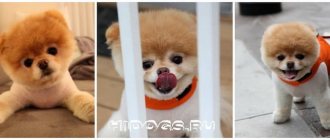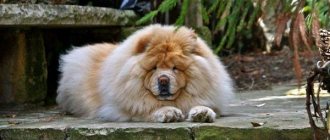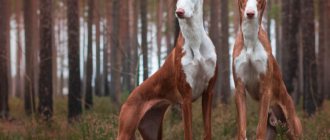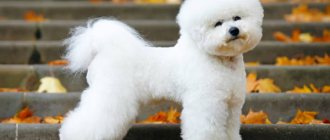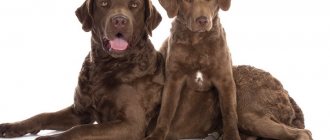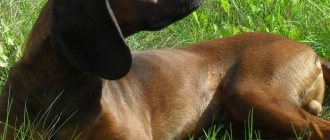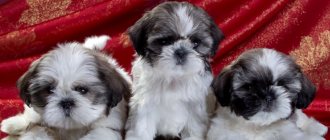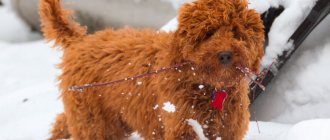This article describes the character and behavior of Petit Brabançon dogs. You will also learn other interesting facts about this breed.
The Petit Brabançon is a Belgian dog breed. It was in this country that it was decided to breed these small dogs.
- This breed has several names, but most often it is called the Brabant Griffon.
- But this name did not come from the name of a flying creature. "Griffon" is a French word that translates to "hard wool" .
- Indeed, dogs of this breed have rather coarse and short hair.
- Belgium has bred several types of griffons, but the most popular is the baby Brabançon. Read more about the characteristics of the breed below.
History of the breed
The most ancient ancestor of the Wolfspitz, as a representative of the Spitz family, is considered to be the turf dog, known since stone times. For the first time, information about dogs similar to each other, identical in appearance, differing only in color and size, appeared in the 16-17th century. In the territory of Pomerania (now the territory of Germany and Poland), red and white Spitz dogs were common, the former being smaller than the latter in size. Wolf-colored Spitz dogs (gray and tan) were actively kept as factory guard dogs in Holland and Germany.
The first Keeshonds were not famous for their modern qualities and appearance. At most, they knew how to notify the area about the invasion of strangers, help shepherds graze their cattle, and were simply good companions. It was precisely because of their not outstanding qualities that the puppies were very accessible and distributed well. Since in those days people often lived quite poorly, keeping dogs for no reason, for communication and love, while fulfilling all the whims of the animal was very unprofitable, and no one needed it. Very strict conditions of detention made the Wolfspitz a very unpretentious dog. Natural selection also played a role in this. Wolfspitz was not considered a high-breed dog for a long time, and lived like this with people until breeders paid attention to him.
The Keeshond-Wolfspitz received its two names in Holland and Germany. It was also very popular in the Netherlands. Keeshonds were often kept by boatmen and sailors to guard barges. It is believed that this is why Keeshonds adore water so much. It was in Germany that the Keeshond-Wolfspitz was identified as a separate breed in the eighteenth century.
Wolfspitz is the German name for the Keeshond. In Germany, it was so nicknamed precisely because of its unusual wolf coloring.
The Wolfspitz received its second name in Holland. Here the history of his name is much more interesting. The Dutch Wolfspitz took an indirect part in the history of Holland, namely in the revolution. The instigator of one of the patriotic uprisings of 1781, Cornelius de Kizlyar, had a favorite - a wolf-colored Spitz. He did not hide his pet, quite the contrary, and therefore the Wolfspitz became the emblem of the conspirators. Keeshond Wolfspitz was nicknamed in honor of the conspirators, who were called Gezes, as supporters of Kizlyar. Cornelius's plans were defeated. The authorities ordered the destruction of everything associated with the rioters. Even the Keeshond got it. The breed began to be exterminated en masse. Fortunately, it was not possible to completely lime the Keeshonds.
In the 18th-19th century, the first club of this breed was opened in Germany, in which all species were classified.
Read: Is the Caucasian Shepherd Dog a formidable protector or a good-natured friend?
In Russia, the Wolfspitz became known and began to gain popularity at the end of the twentieth century. But still, now Keeshond and Wolfspitz do not quite mean the same thing. The Keeshond is today an inbreeding species of Wolfspitz.
The appearance of the smooth-haired lesser griffon in Russia
The official breed standard was adopted in 1904. And the first Petit Brabonçon was brought to Russia much later - in 1993, it arrived from the USA. This event gave rise to the creation of the first Russian breeding nursery (Nevsky Hobbit in St. Petersburg). Later, the breed appeared in the capital, from where it began to spread throughout Russia.
Description of the breed
The Wolfspitz is a medium-sized dog with a harmonious and very compact build. The Spitz Keeshond is the largest representative of the German Spitz breed.
The Wolfspitz's back is not long, slightly lowered towards the croup. The stomach is tucked, and the chest is strong and high. Paws are straight, short, with small round paws, proportional. Fluffy tail in a ring. The muzzle is wedge-shaped, tapering towards the nose. The ears are triangular, small, erect, and set wide apart. Nose and lips are black. The eyes are oval, medium size, dark brown.
The hair is long all over the body, with the exception of the head. The long hair on the neck forms a kind of mane. The coat color is very similar to that of a wolf, as evidenced by the characteristic name; it has white, gray, black or red and brown shades.
Breed standard
As mentioned earlier, the Wolfspitz has a harmonious body structure. It is medium in size in relation to all types of dogs, and large in relation to other types of German Spitz. Spitz dogs with white coloring are usually the largest.
The height of an adult male Keeshond ranges from 43-55 centimeters; the female’s height is no different, the same 43-55. The weight of an adult dog is the same for males and females; it corresponds to height and ranges from 25 to 30 kilograms.
Character and temperament
The Keeshond is a very active dog. With age he becomes calmer, but does not lose his funny liveliness. Famous for its devotion, attentiveness and receptivity. He also has good intellectual abilities. She has good intuition and understands what a person wants from her and what she shouldn’t do, so she rarely gets in the way when the owner has no time for her.
It treats strangers and animals with distrust and greets them on its territory with a loud bark, which is not surprising, because in the past it was known as a guard dog. But at the same time it does not have a pronounced hunting instinct and a tendency to aggression. But he usually gets along well with his people and other pets, without any problems.
Has attachment to his home and owner, does not strive to break free and have an independent existence. Wolfspitz dogs are often called upon to help people with psychological problems because of their intuition, friendliness and cheerfulness.
Health and life expectancy
Keeshonds are very healthy dogs, they have no breed diseases, and they live for quite a long period. And the life expectancy is 13-16 years, and this is not always the limit; there are also long-lived Wolfspitzes. Among the health problems of Wolfspitz dogs, the following can be identified:
- epilepsy;
- heart disease (in older dogs);
- problems with the thyroid gland;
- problems with the adrenal glands.
Disadvantages of the breed
No matter how many advantages and wonderful features the Wolfspitz has, it also has its disadvantages, and they should also be taken into account. The Wolfspitz is unlikely to please people who are accustomed to and value peace and quiet, because it has a loud and ringing bark and is very active. And also thick and long hair requires special careful care, which not all owners like to do.
Read The whole truth about the Coton de Tulear: characteristics of the Madagascar Bichon
Muzzle for Petit Brabançon
A significant disadvantage of the Griffon Petit-Brabançon breed is the passion for picking up everything that is lying badly from the ground, the baby is also very brave and is not averse to getting into a fight with a cat or other dog while walking, so for such cases it is better to purchase a muzzle. It is worth noting that choosing an accessory due to the structural features of the muzzle is not so easy. It is better to choose special muzzles for this breed or, as a last resort, choose the right size accessory made for pugs.
Education and training
As mentioned earlier, the Keeshond is a very smart and capable dog. She can be taught a lot, and her curiosity and intelligence in this matter only brings benefits and speeds up the training process. She has a very flexible character and can develop a wide variety of skills. These could be: strict guard qualities, various sports, the role of a companion, as well as various entertaining skills. They often successfully participate in all sorts of exhibitions and even circus performances, because they have a very beautiful attractive appearance and genuine charm. If the owner treats the Wolfspitz with care and love, then he will certainly respond in kind.
Petit Brabançon diseases
Genetically, the Petit Brabançon dog breed has good health, which is important to maintain with proper care and maintenance. Certain pathologies are also found in such dogs:
- Congenital diseases of the eyes and teeth associated with the structure of the skull that cannot be cured.
- Progressive retinal atrophy and cataracts, the treatment of which is possible only in a veterinary hospital.
- Tendency to viral diseases and skin parasites, for which preventive treatment should be carried out.
- Dislocation of the kneecap.
- Tendency to obesity, the prevention of which is a proper diet and regular physical activity.
- Complications during childbirth, which often end in caesarean section.
Maintenance and care
Wolfspitz is very picky about its habitat. He lives well both in outdoor conditions and in home and apartment conditions. The most difficult thing in caring for a Wolfspitz is hygiene. The Wolfspitz is a very clean animal and rarely gets dirty, so it does not require frequent bathing. Frequent washing, on the contrary, will only harm the dog: it will damage the skin and coat. So you need to bathe them as little as possible, as needed, and any dirt in the coat can be removed with a brush or special dry shampoo.
The only thing that needs special attention is the dog’s eyes and ears. Wash your ears with an antiseptic at least 1-2 times every seven days, and your eyes with chamomile decoction. The Wolfspitz's claws need to be trimmed once a month. Particular attention is paid to the dog's fur. Long and thick hair needs constant brushing to prevent loose hairballs and other dirt from getting tangled in it. The fur should be combed using a brush with long metal teeth or a furminator. Combing should be done as often as possible, even daily, but at least once or twice a week. In addition to combed hair, the pet receives a massage, which has a beneficial effect on its blood circulation. Grooming of the Wolfspitz's coat is not required and is not recommended.
How to feed a Wolfspitz
You can feed your Keeshond with dry food for this breed, in the amount specified in the instructions, or with the right food, in a balanced amount. Feeding is carried out twice a day, before or after the owners eat. The Wolfspitz must be fed strictly in a certain calculated amount, and not allowed to eat more than it should, as it is prone to overeating and obesity. Obesity in a Wolfspitz leads to health problems.
Walks
The Keeshond can do without physical activity, it does not require it, but at the same time it is very active, and will gladly engage in active physical games and activities with its owner. To prevent your pet from getting lost in the crowd, you need to put a harness on it. Keeshond loves to eat very much, and is extremely indiscriminate in this matter. To ensure that he doesn’t eat anything he shouldn’t and doesn’t catch an infection or virus, watch him closely. Feed him before a walk; with a full stomach, he is unlikely to want to eat anything extra.
Read Cane Corso - the pros and cons of a purebred Italian
Clothes for Keeshond
As mentioned above, the Keeshond is a dog that is not picky about its habitat and is resistant to outdoor conditions. Due to his thick coat, he is unlikely to get very cold. But for the winter period it is better to purchase appropriate clothing if you live in an area prone to very low temperatures and very severe frosts. For the autumn, as well as spring and summer seasons, get clothes that protect from rain. Be sure to pay special attention to the size of clothing so that everything is measured accurately and fits correctly on your pet, otherwise it will be uncomfortable for him.
Claws
Like any other dog, the Smooth Griffon is recommended to trim its overgrown nails from time to time. For these purposes, purchase a special nail clipper at a pet store. Before removing the excess, look at the location of the vessel in the claw in the light so as not to injure the animal. If you cut it carelessly, apply a swab soaked in any hemostatic solution (hydrogen peroxide, for example) to the wound. In addition, trim the fur between the paw pads with nail scissors.
How to choose a Keeshond puppy
To begin, choose a suitable nursery that you can trust. To do this, collect the information you need. Visit their websites, read reviews, and if possible, don’t miss the chance to visit exhibitions. When a nursery is chosen, find out about future litters, and all the information about the parents of your future pet, because no one has canceled genetics. Or you can take an already born puppy of two months of age. Decide what you would like to do with your dog: participation in exhibitions and competitions, sports, or just a new funny, cheerful family member. The only thing worth considering is that it will be difficult to predict the abilities and prospects of a puppy at such a young age. Pay attention to the condition of the puppy, its behavior and character. Choose the gender according to your personal preference.

